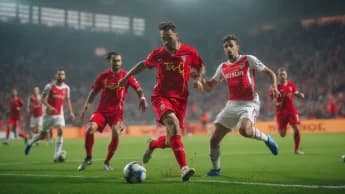The Saudi Pro League has emerged as a significant force in international football, driven by strategic investments, high-profile signings, and a commitment to developing the sport domestically.
In recent years, the Saudi Pro League (SPL) has emerged prominently in the landscape of global football, breaking free from the confines of European football. The league has attracted attention worldwide due to increased investments, notable player signings, and a dedication to enhancing both the quality of the game and its infrastructure. With a strong history of sporting passion and a rich football tradition, Saudi Arabia aims to establish its domestic league as one of the premier football destinations globally.
Originally, the Saudi Pro League began as a regional competition but has since evolved into a league with international aspirations, drawing in some of the top players from around the world. This impressive ascent can be linked to several factors, including attractive contracts for foreign players, significant investments in infrastructure, and a strategic alignment with Saudi Vision 2030, which is the kingdom's ambitious initiative aimed at diversifying its economy and boosting its cultural presence.
Consequently, the SPL is now recognized as an emerging force in global football. The influx of top-tier players and coaches has significantly strengthened its visibility in international media, establishing it as an important contender in the sports arena. This blog will guide you through all you need to understand about the Saudi Pro League, covering its history, structure, international appeal, and the challenges it faces as it continues to evolve.
An Overview of the History of the Saudi Pro League
Founded in 1976, the Saudi Pro League serves as the highest level of club football in Saudi Arabia. At its inception, the competition included only a select few regional teams, and its significance gradually increased over time. For an extended period, the league remained relatively disconnected from the international football landscape, primarily concentrating on developing local talent and offering entertainment to the indigenous audience.
In the 1990s and early 2000s, the league began to attract international attention as Saudi clubs such as Al-Hilal and Al-Ittihad emerged as dominant forces in regional tournaments. These teams routinely competed in the AFC Champions League, which significantly enhanced the visibility of the Saudi Pro League on a continental level. Over the years, the league's competitiveness and overall quality of play have consistently improved, leading to the Saudi Pro League being acknowledged as one of the premier leagues in Asia today.
Over the past ten years, the ambition of the SPL to expand its global presence has made significant strides, particularly through its alignment with Saudi Vision 2030—a long-term initiative aimed at boosting the country's international standing and diversifying its economic influences. The SPL has positioned itself as a crucial contributor to achieving this vision, focusing on both the development of sports and commercial expansion.
Structure and Format
The Saudi Pro League is composed of 18 teams, marking an increase from earlier seasons, which indicates its rising prominence and the growing number of competitive clubs. The league operates on a double round-robin system, where each team competes against every other team twice—once at home and once away—culminating in a total of 34 matches throughout the season.
A team receives 3 points for a win, 1 point for a draw, and 0 points for a loss. At the conclusion of the season, the team with the highest points total is declared the Saudi Pro League Champion. If there is a tie in points, the champion is determined by goal difference. The leading teams are awarded spots in continental tournaments, particularly the AFC Champions League.
Teams at the bottom of the standings risk being relegated to the Saudi First Division League, while the leading teams from that lower league earn promotion to the SPL. This setup fosters a competitive atmosphere, motivating every club to strive for strong performances in order to evade relegation and secure their position in the premier league.
Furthermore, the SPL places considerable importance on its regulations regarding foreign players. Clubs are permitted to include as many as 8 foreign players in their rosters, a strategy that has significantly improved the quality of play in the league by drawing in international talent. This approach has transformed the Saudi Pro League into a sought-after location for both renowned stars and up-and-coming players from around the world.
The Vision Driving the Expansion of the SPL
The revitalization of the Saudi Pro League is directly tied to Saudi Vision 2030, which is the kingdom’s ambitious framework aimed at decreasing reliance on oil while branching out into sectors like tourism, sports, and entertainment. Within this strategy, football holds significant importance, and the SPL has been a key player in driving this initiative forward.
Significant financial resources have been invested by the Saudi government and private entities into the league, with the goal of positioning it to compete with leading European leagues. This initiative includes providing competitive salaries and contracts to international players, improving infrastructure, and greatly enhancing the league's commercial attractiveness.
The Saudi Pro League has experienced a significant rise in investment through increased sponsorship agreements, partnerships, and media rights. Global brands and international companies are now keen to align themselves with the league, taking advantage of the surging popularity of football in the Middle East. Furthermore, the arrival of foreign superstars has not only boosted the league's level of competition but has also expanded its visibility to audiences around the world.
The vision extends beyond merely attracting star players; it emphasizes the importance of nurturing domestic football talent. Saudi Arabia is determined to cultivate more homegrown athletes who can compete at elite levels. To accomplish this, significant investments in grassroots football, coaching initiatives, and youth academies have become essential. The overarching aim is for the Saudi Pro League to evolve into a self-reliant organization with a solid foundation of local talent while still drawing global attention.
International Stars in the SPL
A pivotal moment in the ascent of the Saudi Pro League occurred with the signing of Cristiano Ronaldo by Al-Nassr in January 2023. This major transfer captured global attention and made the SPL a topic of discussion internationally. Ronaldo's presence not only elevated the league's status but also drew significant media coverage, sponsorship opportunities, and increased viewership.
After Ronaldo's arrival, other elite players began to entertain the idea of joining the SPL, fostering a perception that the league was evolving into a worldwide hub for premier football talent. Notable international stars who have followed in Ronaldo's path include:
These player acquisitions have significantly enhanced the SPL’s reputation and attracted global interest in the league. For viewers beyond Saudi Arabia, witnessing elite athletes compete in the SPL has become a thrilling opportunity. The presence of these international stars has also drawn the attention of global broadcasters, enhancing the league's profile and establishing a stronger connection with football enthusiasts around the world.
Broadcasting and International Presence
Recently, the Saudi Pro League has made substantial strides in enhancing its broadcasting agreements, enabling the league to be accessible in more than 170 countries. This strategic shift has been vital in reaching an international audience. Now, the SPL's matches are broadcasted on various platforms, including major sports networks, making the league reachable in millions of households around the globe.
The enhanced accessibility of the SPL stems from a well-thought-out strategy aimed at allowing fans around the globe to engage with the league and its prominent players. The transition to digital media has significantly contributed to expanding the SPL's international presence, enabling fans to view matches via mobile applications, streaming services, and social media platforms.
Broadcasting rights and sponsorship agreements have been crucial in generating revenue for the league. International media outlets have acknowledged the economic potential of the SPL, and the expansion of the league's fan base has been driven by its worldwide outreach. Additionally, providing commentary and coverage in multiple languages enhances accessibility for various international markets, ensuring that the SPL reaches a broader audience.
Challenges to Overcome
Despite the impressive growth of the Saudi Pro League, it faces several challenges as it strives to maintain its upward momentum. The most critical concern is sustainability. The high salaries offered to international players, along with significant investments in infrastructure and facilities, have sparked worries about the league's long-term financial stability. It is essential to adopt a balanced strategy to prevent the SPL from becoming overly dependent on outside investment.
A significant challenge facing the league is maintaining competitive balance. The substantial financial resources of leading clubs such as Al-Hilal, Al-Nassr, and Al-Ittihad have resulted in a scenario where these wealthiest teams can recruit the most talented players, which in turn leaves smaller clubs at a disadvantage. This inequality could affect the overall competitive nature of the league and might hinder the progress of lower-tier teams.
Cultivating local talent presents a significant challenge. Although the arrival of international stars has elevated the league's quality, it is essential for Saudi Arabia to nurture its own football talent capable of competing at the highest levels. Creating top-tier training academies, improving youth development programs, and enhancing coaching efforts are critical for ensuring the long-term success of the Saudi Pro League.
Prospects for the Future
In the future, the Saudi Pro League has set ambitious objectives. The league aims to achieve greater financial autonomy, diversify its income sources, and increase its presence on the global stage. Additionally, Saudi Arabia aspires to host international sporting events such as the FIFA World Cup, with the SPL playing a crucial role in this strategy.
The growing presence of international players, the development of infrastructure, and the expansion of business opportunities all suggest a promising outlook for the SPL. The league's commitment to enhancing the quality of play and drawing in larger audiences is certain to influence its role in the world of football for many years ahead.
In recent years, the Saudi Pro League (SPL) has emerged prominently in the landscape of global football, breaking free from the confines of European football. The league has attracted attention worldwide due to increased investments, notable player signings, and a dedication to enhancing both the quality of the game and its infrastructure. With a strong history of sporting passion and a rich football tradition, Saudi Arabia aims to establish its domestic league as one of the premier football destinations globally.
Originally, the Saudi Pro League began as a regional competition but has since evolved into a league with international aspirations, drawing in some of the top players from around the world. This impressive ascent can be linked to several factors, including attractive contracts for foreign players, significant investments in infrastructure, and a strategic alignment with Saudi Vision 2030, which is the kingdom's ambitious initiative aimed at diversifying its economy and boosting its cultural presence.
Consequently, the SPL is now recognized as an emerging force in global football. The influx of top-tier players and coaches has significantly strengthened its visibility in international media, establishing it as an important contender in the sports arena. This blog will guide you through all you need to understand about the Saudi Pro League, covering its history, structure, international appeal, and the challenges it faces as it continues to evolve.
An Overview of the History of the Saudi Pro League
Founded in 1976, the Saudi Pro League serves as the highest level of club football in Saudi Arabia. At its inception, the competition included only a select few regional teams, and its significance gradually increased over time. For an extended period, the league remained relatively disconnected from the international football landscape, primarily concentrating on developing local talent and offering entertainment to the indigenous audience.
In the 1990s and early 2000s, the league began to attract international attention as Saudi clubs such as Al-Hilal and Al-Ittihad emerged as dominant forces in regional tournaments. These teams routinely competed in the AFC Champions League, which significantly enhanced the visibility of the Saudi Pro League on a continental level. Over the years, the league's competitiveness and overall quality of play have consistently improved, leading to the Saudi Pro League being acknowledged as one of the premier leagues in Asia today.
Over the past ten years, the ambition of the SPL to expand its global presence has made significant strides, particularly through its alignment with Saudi Vision 2030—a long-term initiative aimed at boosting the country's international standing and diversifying its economic influences. The SPL has positioned itself as a crucial contributor to achieving this vision, focusing on both the development of sports and commercial expansion.
Structure and Format
The Saudi Pro League is composed of 18 teams, marking an increase from earlier seasons, which indicates its rising prominence and the growing number of competitive clubs. The league operates on a double round-robin system, where each team competes against every other team twice—once at home and once away—culminating in a total of 34 matches throughout the season.
A team receives 3 points for a win, 1 point for a draw, and 0 points for a loss. At the conclusion of the season, the team with the highest points total is declared the Saudi Pro League Champion. If there is a tie in points, the champion is determined by goal difference. The leading teams are awarded spots in continental tournaments, particularly the AFC Champions League.
Teams at the bottom of the standings risk being relegated to the Saudi First Division League, while the leading teams from that lower league earn promotion to the SPL. This setup fosters a competitive atmosphere, motivating every club to strive for strong performances in order to evade relegation and secure their position in the premier league.
Furthermore, the SPL places considerable importance on its regulations regarding foreign players. Clubs are permitted to include as many as 8 foreign players in their rosters, a strategy that has significantly improved the quality of play in the league by drawing in international talent. This approach has transformed the Saudi Pro League into a sought-after location for both renowned stars and up-and-coming players from around the world.
The Vision Driving the Expansion of the SPL
The revitalization of the Saudi Pro League is directly tied to Saudi Vision 2030, which is the kingdom’s ambitious framework aimed at decreasing reliance on oil while branching out into sectors like tourism, sports, and entertainment. Within this strategy, football holds significant importance, and the SPL has been a key player in driving this initiative forward.
Significant financial resources have been invested by the Saudi government and private entities into the league, with the goal of positioning it to compete with leading European leagues. This initiative includes providing competitive salaries and contracts to international players, improving infrastructure, and greatly enhancing the league's commercial attractiveness.
The Saudi Pro League has experienced a significant rise in investment through increased sponsorship agreements, partnerships, and media rights. Global brands and international companies are now keen to align themselves with the league, taking advantage of the surging popularity of football in the Middle East. Furthermore, the arrival of foreign superstars has not only boosted the league's level of competition but has also expanded its visibility to audiences around the world.
The vision extends beyond merely attracting star players; it emphasizes the importance of nurturing domestic football talent. Saudi Arabia is determined to cultivate more homegrown athletes who can compete at elite levels. To accomplish this, significant investments in grassroots football, coaching initiatives, and youth academies have become essential. The overarching aim is for the Saudi Pro League to evolve into a self-reliant organization with a solid foundation of local talent while still drawing global attention.
International Stars in the SPL
A pivotal moment in the ascent of the Saudi Pro League occurred with the signing of Cristiano Ronaldo by Al-Nassr in January 2023. This major transfer captured global attention and made the SPL a topic of discussion internationally. Ronaldo's presence not only elevated the league's status but also drew significant media coverage, sponsorship opportunities, and increased viewership.
After Ronaldo's arrival, other elite players began to entertain the idea of joining the SPL, fostering a perception that the league was evolving into a worldwide hub for premier football talent. Notable international stars who have followed in Ronaldo's path include:
These player acquisitions have significantly enhanced the SPL’s reputation and attracted global interest in the league. For viewers beyond Saudi Arabia, witnessing elite athletes compete in the SPL has become a thrilling opportunity. The presence of these international stars has also drawn the attention of global broadcasters, enhancing the league's profile and establishing a stronger connection with football enthusiasts around the world.
Broadcasting and International Presence
Recently, the Saudi Pro League has made substantial strides in enhancing its broadcasting agreements, enabling the league to be accessible in more than 170 countries. This strategic shift has been vital in reaching an international audience. Now, the SPL's matches are broadcasted on various platforms, including major sports networks, making the league reachable in millions of households around the globe.
The enhanced accessibility of the SPL stems from a well-thought-out strategy aimed at allowing fans around the globe to engage with the league and its prominent players. The transition to digital media has significantly contributed to expanding the SPL's international presence, enabling fans to view matches via mobile applications, streaming services, and social media platforms.
Broadcasting rights and sponsorship agreements have been crucial in generating revenue for the league. International media outlets have acknowledged the economic potential of the SPL, and the expansion of the league's fan base has been driven by its worldwide outreach. Additionally, providing commentary and coverage in multiple languages enhances accessibility for various international markets, ensuring that the SPL reaches a broader audience.
Challenges to Overcome
Despite the impressive growth of the Saudi Pro League, it faces several challenges as it strives to maintain its upward momentum. The most critical concern is sustainability. The high salaries offered to international players, along with significant investments in infrastructure and facilities, have sparked worries about the league's long-term financial stability. It is essential to adopt a balanced strategy to prevent the SPL from becoming overly dependent on outside investment.
A significant challenge facing the league is maintaining competitive balance. The substantial financial resources of leading clubs such as Al-Hilal, Al-Nassr, and Al-Ittihad have resulted in a scenario where these wealthiest teams can recruit the most talented players, which in turn leaves smaller clubs at a disadvantage. This inequality could affect the overall competitive nature of the league and might hinder the progress of lower-tier teams.
Cultivating local talent presents a significant challenge. Although the arrival of international stars has elevated the league's quality, it is essential for Saudi Arabia to nurture its own football talent capable of competing at the highest levels. Creating top-tier training academies, improving youth development programs, and enhancing coaching efforts are critical for ensuring the long-term success of the Saudi Pro League.
Prospects for the Future
In the future, the Saudi Pro League has set ambitious objectives. The league aims to achieve greater financial autonomy, diversify its income sources, and increase its presence on the global stage. Additionally, Saudi Arabia aspires to host international sporting events such as the FIFA World Cup, with the SPL playing a crucial role in this strategy.
The growing presence of international players, the development of infrastructure, and the expansion of business opportunities all suggest a promising outlook for the SPL. The league's commitment to enhancing the quality of play and drawing in larger audiences is certain to influence its role in the world of football for many years ahead.







